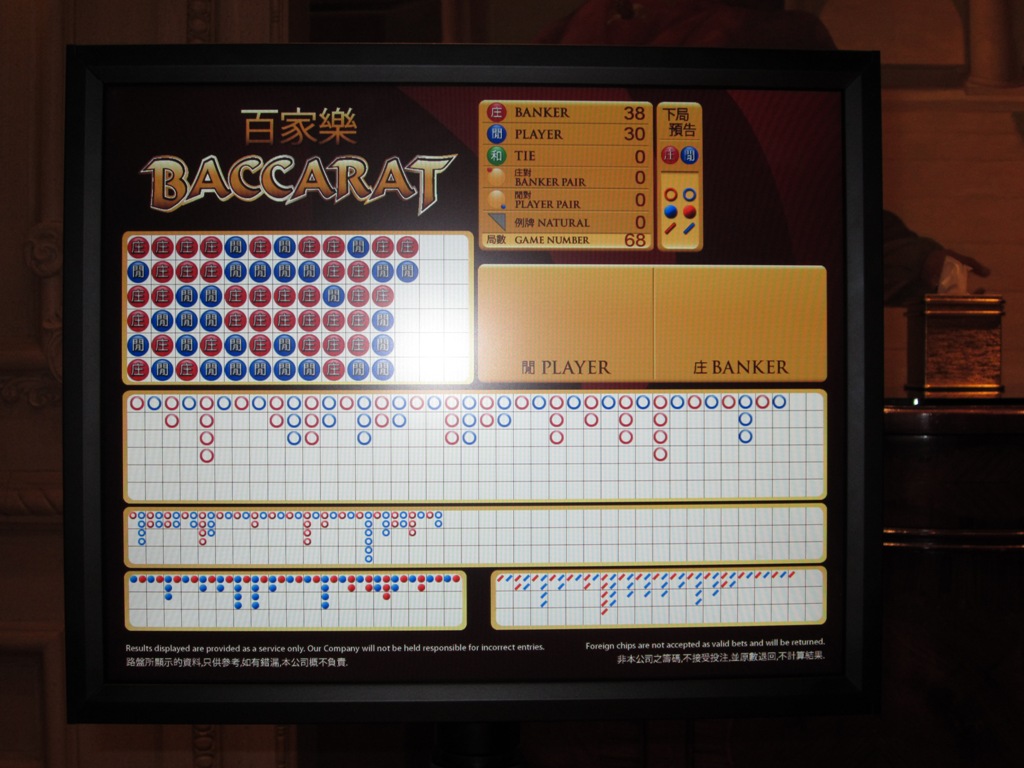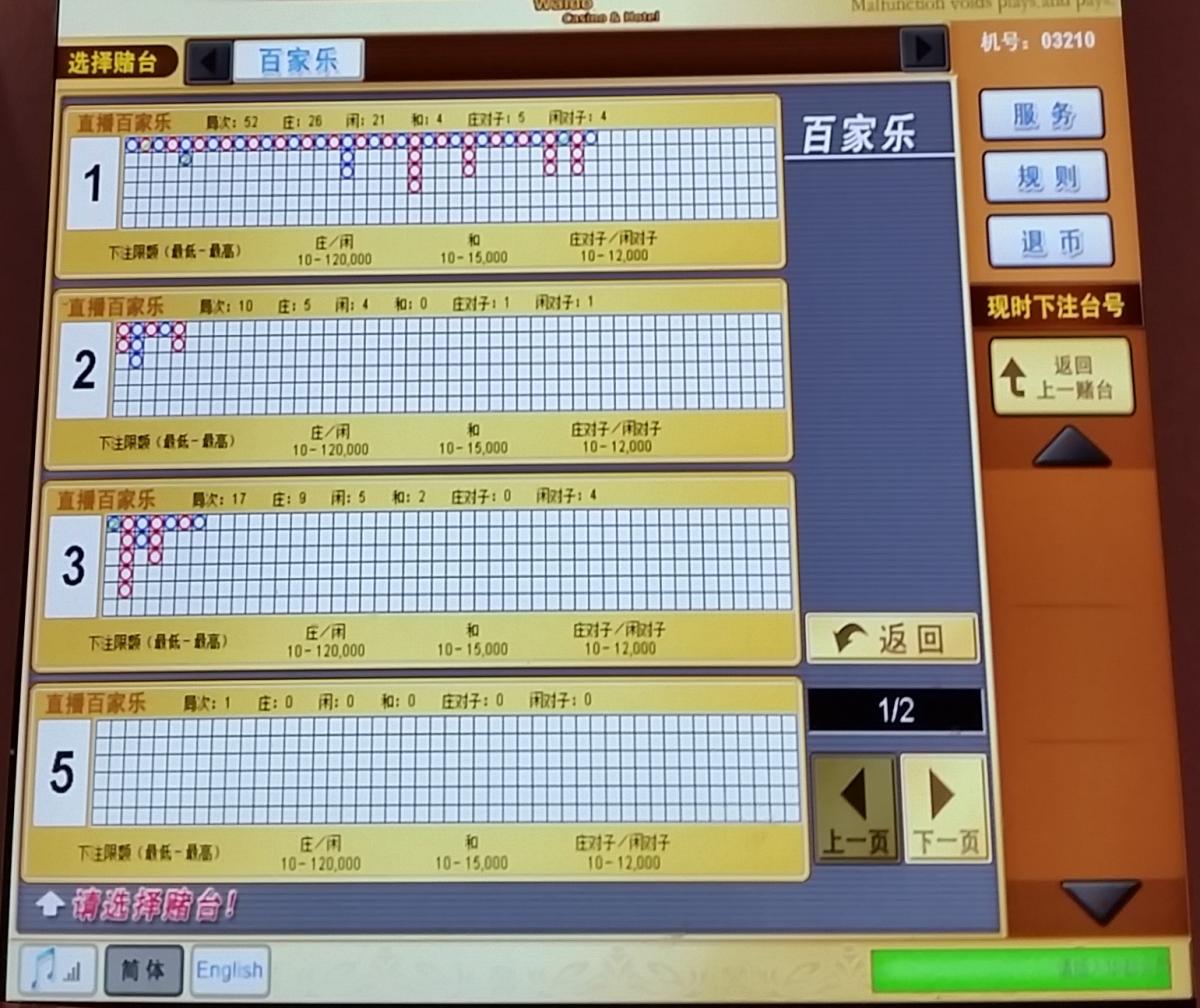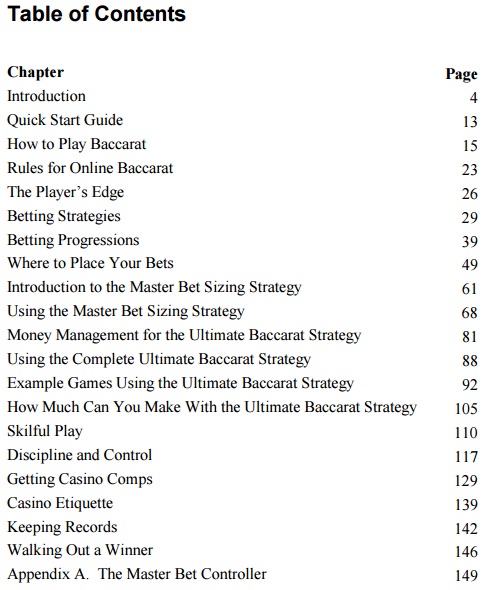Baccarat Angst

- Identify and follow trends and streaks. The belief that if a thing happens, then it is more likely to continue to happen. More than any other method, baccarat players worldwide attempt to identify and follow trends and streaks.
- The gambler's fallacy (regression to the mean). The belief that if a thing has happened more than it should, then it is less likely to happen in the future. Conversely, the belief that underrepresented past events become due. The belief that things even out; the shoe wants to "balance."
- Money management, timing, discipline. The belief that by stopping at certain pre-targeted win/loss quit-points, the player can beat the house.
- Betting progressions and systems. The belief that a system of wagering where the current wager is based on past outcomes can be used to beat the house.
- Betting with the big player. The belief that the big player should be allowed to make decisions for the entire table because he likely has a better understanding of which wager (Banker/Player) is more likely to win.
- Card counting systems. The belief that baccarat, like blackjack, can be beaten by card counting.
Other lesser baccarat superstitions include:
- Squeezing, turning and blowing on the cards.
- Going to the toilet when on a losing streak.
- Leaving the lights on before you go out to gamble.
- Not having sex for two days before gambling.
- The direction when entering the casino.
- Bringing a lucky charm.
- Shouting or saying certain expressions at the table.

This picture is care of Michael Shackleford, the Wizard of Odds. The question I ask is, "what is the correct next bet here?" Ask yourself that question. Click on the image to make it larger if you want to give it more careful thought.
The best bet (assuming you are going to make a bet) is obvious. Bet on Banker. Why? It has the lowest house edge out of the three choices (Player / Banker / Tie). Nothing in that picture matters when it comes to making this decision.
These devices exist worldwide. If you think they have any value in helping the player, you are mistaken. Imagine a scoreboard on a blackjack table telling the player the hi-lo true count, as well as the insurance count and a side count of Aces. Why doesn't such a scoreboard exist? Because it helps the player. Why does this baccarat scoreboard exist? Because it helps the casino.
Here is a picture of a scoreboard from a stadium baccarat area at a large Asian casino (thanks to the reader who emailed this to me). This picture gives three boards simultaneously being dealt at the center of the stadium. Blue = Player, Red = Banker. Quiz: what would you bet on in each of the three shoes pictured (click to make the image larger)?

Using these scoreboards helps players identify false patterns which inspires the players to make larger wagers chasing the elusive streaks they portend. Larger wagers means more casino profit. Bet on Banker every time, if you must bet at all.
Another value these scoreboards have for the casino is that they speed up the game compared to the old-fashioned method of keeping score by hand. However, writing out these scorecards by hand somehow helps players convince themselves there is meaning in this noise where the electronic scoreboards do not. Again, if you saw this scorecard, what would you bet? I would bet on Banker.

I recently decided to take the dive and buy a few baccarat books in order to see what the intellectually curious baccarat player would find. I went to Amazon and searched for baccarat books. I was looking for something relatively cheap, non-kindle, and fairly high up on the rating list. In the end, I purchased five random books and one book I had previously heard good things about.
I've been having a hard time opening these books, let alone reading them. Most of the content makes no sense to me, though I am sure the author believes that what they are saying has meaning and value. I don't deny the author's faith in his content. However, from the standpoint of the scientific principles behind beating casino games, I can only describe my overall experience reading these books as angst-ridden.
Here are some choice quotes from these books:
The Basics of Winning Baccarat, by Avery Cardoza:
[There are actual card counting systems for baccarat. These systems win pennies on $1000 wagers. See this post. What is true is that baccarat counting systems have nothing to do with the counting tags given by Cardoza. What exactly is "in-house" research?]
Our own in-house research has shown that the two through six are cards that favor the Player position, while the rest of the cards, eight through the king, favor the Bank. The aces and sevens have little effect on either position and are considered neutral.
By tracking the removal of these cards, you can gain an edge by betting Player when there is a higher ratio than normal of twos through sixes remaining in the deck, and Bank when there is a higher ratio of the high cards, eights through kings, remaining.
[Shoes like to "re-center," in other words, the gambler's fallacy in its purest form. As for his 232 shoes, I could shorten my simulations by 999,999,768 shoes.]
The important thing to remember here is that we can be quite confident in the final distribution of wins of three hands over many sets of three hands we play. The same thing applies to the number of singletons compared to runs, runs of length two compared to runs of length three or more, and so on.
In each case, the mathematics tell us what to expect on average over many plays. Given that we expect 50-50 on average, you can think of that as the balance point. As you see outcomes (such as the number of singletons compared to runs) get farther and farther away from the 50-50 point, you can think of it as the shoe going off center.
Fortunately we can quantify how often you'll see the shoe go off center. Although the shoe may end up staying off balance, it seems prudent to bet that it will more likely re-center itself.
[In case you've never heard of John Patrick, this advice should give you the whole story. It doesn't matter what betting system you use, just use a system!]
You're supposed to have a positive pattern in your method of betting, wherein every single bet you make is pre-determined, and based on the outcome of the previous hand.
I've told you what to bet when you win -- using the "up and pull" method of betting, and told you to go all the way back to the minimum bet in your series when you lost.(sic)
If you do not like my betting patterns, go make up your own. But be comfortable with the one you decide upon, and have that series based on your starting bankroll.
I don't give a rat's tail which system you use, or whether you bet conservative or aggressive. I like conservative, but suit yourself. I just want you to have an intelligent money management system, and abide by it.
[Streak betting at its finest.]
The Rule of Three says that if a thing happens three times in a row, you either bet on the streak, or you don't bet at all.
Let's use baccarat as an example. The Bank side has won three times in a row. Which side do you bet on now? We know the Bank and Player have almost equal chances to come up, not unlike heads or tails in a coin toss.
You can say, "Bank has come up three times, so now is the time to bet Player."
You could be right.
Now suppose the Bank side wins again. That makes four in a row.
Now you're sure Player will come up, so you bet it again.
Suicide.
Under my rule, you go with the flow or you don't go.
[I know Henry Tamburin personally. I have spoken with him about this book. He now admits that much of his work on card counting is flawed. He, unlike most, is willing to accept scientific proof.]
Analysis of all our baccarat lab computer tests indicate that the true casino percentage on Bank hand bets is probably closer to 1.0 percent than it is to the 1.17 percent figure established for a top of the shoe condition. We estimate that proper use of the counting systems set forth in this section (the test results of which were evaluated relative to straight Bank hand bets) will further reduce the casino percentage by one-half to three-quarters of a percentage point. This reduces the casino percentage to practically nothing and makes baccarat the best casino game for those who do not want to get involved with the hassles associated with counting in blackjack.
[There are real methods to beat baccarat -- you'll find plenty of them on this site. But, as far as I can tell, there is exactly one pure baccarat book on the market that discusses any of these methods at length. I'm going to give this one book a shout-out, even though some of the content greatly exaggerates the potential of the methods it presents. Here are some sample quotes.]
There is a new category of baccarat systems seller emerging who pretends to sell winning card-counting systems ...
A computer could tell me exactly when any of the three bets [Player, Banker, Tie] was favorable. All I had to do was tell it which cards had been dealt. Unfortunately, when I wrote a program to detect advantageous situations on my home computer the results were not spectacular. With a game dealt down to ten cards and perfect wagering any time there was a favorable situations, I could expect to earn approximately 4.5 percent per shoe of whatever amount I bet ... So, if I bet $1,000 every time my computer told me I had an edge, I'd make $45 for every shoe I played.
[See this post for a comparison of May's results with my own.]
[There is one book that I want to single out. I've had this book in my library for quite some time. It is a college-level textbook for a course on casino management that happens to include some information about baccarat. What I read in this book just floored me with its stupidity. It's one thing for random gaming authors to come up with this stuff. It's an entirely different matter when nonsense is passed off as science at the college level.]
Because there are only two major bets, the simplest strategy is to bet the minimum, usually $20 and alternate bets -- banker, player, banker, player, and so on. Unless you have a really bad run of luck, you should at least break even, since there is almost an even split between the two hands. However, with this strategy, you must pull $20 from the second win so that you bet with the casino's money, not yours ... Since the odds are around 50% that one of those hands will turn up, it is a simple bet and you shouldn't go too far astray.
Baccarat Attack Strategy: "Attack, Retrench and Win" by Greg Fletcher
[I found the book online as a pdf. Its table of contents reads like an itemized list of gambling mythologies (click on the image to make it larger).]

The story doesn't end with books. A simple Google search on "baccarat betting systems" leads to dozens of sites pushing baccarat nonsense. Here are a few anxiety-causing article titles:
- The 1-3-2-4 Baccarat gambling strategy explained and tested
- The Paroli Betting System
- 1-3-2-6 System - Baccarat System
- Fibonacci System - Baccarat System
- #1 Baccarat System! Win $1,410 an Hour Making $10 Bets
- "Beating Baccarat" Could This Get You Barred From Casinos?
- Baccarat BREAKTHROUGH Win When Winning Win when Losing!
- Baccarat System Profits Guaranteed
- Baccarat Strategy from Casino Specialists
- Shift 5 Baccarat System Tutorial Bet Selection Method Strategy
In this blog and in my other writings, I have not previously addressed the mountain of baccarat misinformation that's pushed onto the intellectually curious player. Out of the seven books mentioned above, only John May's book is worth buying. Simple searches on Google and YouTube offer almost nothing of value. And this is just the English language market.
Baccarat, more than any other casino game, inspires the irrational and unsound argument.
I don't begrudge the casino its profit, after all, I work for the casino industry. But I also work on behalf of fact-based information for anyone who is honestly seeking truth. Getting a good baccarat education should not be such a challenge. It's a baccarat desert out there. But there are a few oases. Find them.
Note. All material quoted from copyrighted sources in this article is being used under the fair use doctrine for educational purposes.


